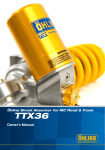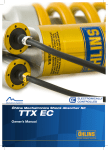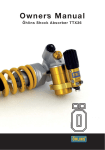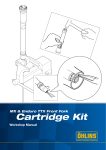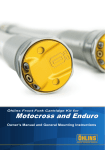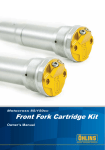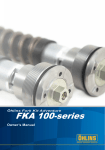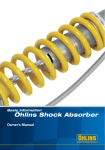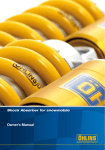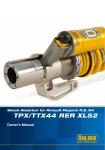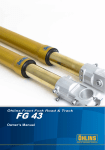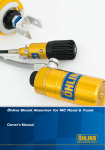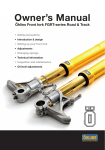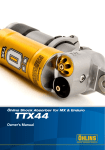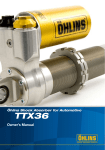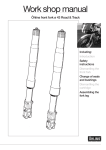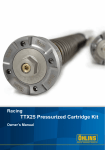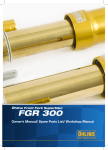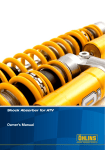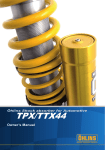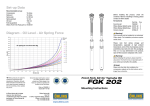Download 30 mm Front Fork Cartridge Kit
Transcript
Road & Track 30 mm Front Fork Cartridge Kit Owner’s Manual Introduction Öhlins Racing AB - The Story It was the 1970’s, a young man named Kenth Öhlin spent most of his spare time pursuing his favourite sport: motocross. Congratulations! You are now the owner of an Öhlins Front Fork Cartridge Kit. More than two hundred World Championships and other major world titles are definitive proof that Öhlins products offer outstanding performance and reliability. A careful observer, Kenth’s attention was continually drawn to one specific detail motocross bikes had more engine power than their suspension could handle. It was not long before Kenth realised that better performance could be achieved by improved wheel suspension. Every product has gone through rigorous testing and engineers have spent thousands of hours, doing their very best to use every possible experience from our 30 years within the racing sport. The product that you now have in your possession is pure racing breed that is built to withstand. Öhlins Racing was established in 1976, and just two years later the company won its first World Championship title. Despite being in the business for 30 years, the search for perfection and new functions is still the main focus of the company. By installing this Front Fork Cartridge Kit on your bike you have made a clear statement… you are a serious rider with a focus on getting the maximal handling ability and outstanding feedback from your bike. Along comes the fact that your Front Fork Cartridge Kit will be a long lasting friend, delivering the very best of comfort and performance every time you go for a ride. Go explore! 1 Safety Precautions Note! Safety Symbols The front fork is a very important part of the vehicle and will therefore affect the stability. Read and make sure that you understand the information in this manual and the mounting instructions before you use this product. If you have any questions regarding installation or maintenance please contact an Öhlins dealer. In this manual, mounting instructions and other technical documents, important information concerning safety is distinguished by the following symbols: The Safety Alert Symbol means: Warning! Your safety is involved. Öhlins Racing AB can not be held responsible for any damage to the front fork, vehicle, other property or injury to persons, if the instructions for installing and maintenance are not followed exactly. Warning! The Warning Symbol means: Failure to follow warning instructions can result in severe or fatal injury to anyone working with, inspecting or using the front fork, or to bystanders. Warning! This product was developed and designed exclusively for a specific vehicle model and should only be installed on the intended vehicle model in its original condition as delivered from the vehicle manufacturer. Caution! The Caution Symbol means: Special precautions must be taken to avoid damage to the front fork. After installing this product, take a test ride at low speed to make sure that your vehicle has maintained its stability. Note! The Note Symbol indicates information that is important regarding procedures. If the suspension makes an abnormal noise, or the function is irregular, or if you notice any leakage from the product, please stop the vehicle immediately and return the product to an Öhlins Service Centre. Note! When working on this product, always consult your Vehicle Service Manual. This Manual should be considered a part of the product and should therefore accompany the product throughout its life cycle. © Öhlins Racing AB. All rights reserved. Any reprinting or unauthorized use without the written permission of Öhlins Racing AB is prohibited. Printed in Sweden. 2 Contents Introduction Safety Precautions Contents 1 - Front Fork Cartridge Kit 2 - Design and Function 3 - Setting up Your Front Fork 4 - Adjustments 4.1 - Adjusters 4.2 - Spring 4.3 - Oil Level 4.4 - Fork Leg Position 4 - Change Spring and Check/Change Oil Level 5 - Technical Specifications 6 - Inspection and Maintenance 3 1 2 3 4 5 9 10 10 11 11 12 14 14 1 - Front Fork Cartridge Kit Introduction The product in your hand is an artwork, prepared by our dedicated craftsmen at our facility in Upplands Väsby, Sweden. Its predecessors have battled their way on numerous race tracks in World Superbike, Supersport, Superstock and AMA and the legacy continues in your front fork. Thousands of hours have been spent together with some of the best teams in the world to find the optimal design and functionality to give you as much performance and comfort as possible. You will feel the difference…be sure. Our engineers that work on a daily basis with the top riders in the world often hear the word “feeling” and “control” when they debrief after tests and races. We wanted to pour as much of these important factors into your front fork cartridge kit and, as a result, the new 30 mm front fork cartridge kit gives you improved “brake support” and “tire feel” when riding. For all of you that have your mind set on doing some serious racing we have some really good news. Of course we have improved the design so that you easily can have it properly maintained and every kit is individually tested with an optimum setting, spring and top-out spring. The new top-cap design will send a signal to all curious spectators when you pull over next to your favourite café or local race track… it’s a signal that says that the owner of the bike has made his choice to go straight for the podium. Now we are raising the new 30 mm front fork cartridge kit to a new level. Design The DNA of this new 30 mm front fork cartridge kit originates in the most prestigious race series in the world and the front fork cartridge kit is weight optimized as a result of that fact. We have used exclusive racing components from our R&D department to increase the performance of the front fork cartridge kit. 4 2 - Design and Function The front fork cartridge kit is divided into one compression cartridge and one rebound cartridge. The compression cartridge is installed in the left front fork leg and the rebound cartridge in the right front fork leg. Marked at the top cap is “COMP” for compression adjustment and “REB” for rebound adjustment (Fig. 1). The compression and rebound cartridges are both of the same design but works opposite each other. To achieve rebound damping force instead of compression damping force, the cylinder tubes and the pistons are turned opposite each other between the compression and the rebound cartridges (Fig. 2). When the front fork moves, the fluid inside is forced to flow through the pistons. At a compression movement the fluid is forced through the compression shim stack and at the same time through the rebound check valve. And opposite, at a rebound movement the fluid is forced through the rebound shim stack and through the compression check valve. The fluid displaced by the piston shafts are directed either into or out of the cylinder tubes through the holes. (Fig. 2) Fig. 1 - Cartridges The compression and the rebound pistons are both of the same design. The pistons have three flow paths for the fluid: 1. Bleed valve (Fig. 3 centre gray arrows). Small orifice that creates a flow restriction simply by being small. 2. Shim valve (Fig. 3 outer black arrows). Fluid pressure has to deflect thin steel washers (shims) to open up an orifice and allow fluid to flow through it. 3. Check valve (Fig. 3 outer white arrows). A spring preloaded shim that opens easily, for return flow of fluid when the direction of movement of the front fork changes. The bleed valve and shim valve are used to build up damping force. At slow stroke speeds the percentage going through the bleed valve is higher and at fast strokes the shim valve takes care of most of the flow. The check valve, together with the bleed valve (since it can flow both directions), handle return flows. To control damping force the bleed valve can be changed by the external adjuster, compression and rebound. By altering the stiffness of the shim stack (number, thickness, diameter and shape) on the shim valve the characteristics of the damping action can be changed. This should only be done by an authorized Öhlins service workshop. Rebound Cartridge Top cap marked “REB” Cylinder tube Compression Cartridge 5 Top cap marked “COMP” 2 - Design and Function Fig. 2 - Schematic View Compression Front Fork Leg Rebound Front Fork Leg Cylinder tube holes Shim stack Check valve Piston Piston Check valve Shim stack Cylinder tube holes Fig. 3 - Piston Oil Flow Compression Rebound bleed valve flow bleed valve flow Shim stack Check valve Piston shim valve flow check valve flow Piston check valve flow shim valve flow Check valve Shim stack 6 2 - Design and Function Compression damping Rebound damping Compression front fork leg When movement of the motorcycle causes compression of the front fork (Fig. 4 compression movement), the fluid below the compression piston is pressurized and goes through: • Compression shim valve • Compression bleed valve Rebound front fork leg When the spring forces the front fork to extend again (Fig. 5 rebound movement), the fluid above the rebound piston is pressurized and in a similar pattern as compression movement, goes through: • Rebound shim valve • Rebound bleed valve Rebound front fork leg The pressure difference between the inside of the front fork leg and above the rebound piston causes the fluid to go through: • Rebound check valve • Rebound bleed valve (Small and insignificant flow compared to the check valve) Compression front fork leg As similar the rebound front fork leg at a compression movement, the pressure difference between the inside of the front fork leg and below the compression piston causes the fluid to go through: • Compression check valve • Compression bleed valve (Small and insignificant flow compared to the check valve) Displaced fluid During compression movement, the piston shafts enter the cylinder tubes and the correspondingly displaced volume of fluid has to flow out of the cylinder tubes through the holes. Displaced fluid The fluid that was displaced by the piston shafts is now pushed back into the cylinder tubes by the pressure difference between the inside of the front fork legs and above and below the pistons. 7 2 - Design and Function Fig. 4 - Front Fork Oil Flow Compression Movement Compression Front Fork Leg Fig. 5 - Front Fork Oil Flow Rebound Movement Compression Front Fork Leg Rebound Front Fork Leg Cylinder tube holes Shim stack Piston Check valve Check valve Piston Shim stack Cylinder tube holes 8 Rebound Front Fork Leg 3 - Setting up your Front Fork Recommended Measures If no other recommendations are given in the Mounting Instructions follow the measures below: Warning! Before riding, always ensure that the basic settings made by Öhlins are intact. Take notes, adjust in small steps and make only one adjustment at a time. Free sag/ Without Rider (R1-R2), (F1-F2) Rear 5 - 15 mm Front 20 - 30 mm Step 1 Ride height/ With Rider (R1-R3), (F1-F3) Rear 25 - 35 mm Front 30 - 40 mm Spring Preload - Free Sag - Ride Height Spring preload is a crucial part of setting your motorcycle since it affects the height of the motorcycle and the fork angle. Before setting the preload, measure the sag: Note! Always check on the Öhlins web site www.ohlins.com or with your Öhlins dealer/ distributor for the latest information. Note! The following procedure should be performed on a flat surface. Step 2 1. Put the motorcycle on a workstand so that both wheels are off the ground and the suspension is unloaded. 2. Mark, for example with a piece of tape, a point immediately above the rear wheel axle. 3. Measure the distance from the marked point to a fixed point, for example the wheel axle (R1). 4. Measure the distance from the bottom of the upper triple clamp to a fixed point, for example the front wheel axle (F1). 5. Put the motorcycle on the ground so that the front and the rear suspensions are slightly compressed. Repeat the measuring procedures (R2 and F2). 6. Sit on the motorcycle in normal riding position, properly outfitted in your riding gear. Repeat the measuring procedure (R3 and F3). Adjust spring preload 1. If your measures differ significantly from the recommendations in the Mounting Instructions or the table above, adjust the spring preload. (See chapter Spring Preload in this manual). 2. If the ride height still differs from the recommendations, you may need to change to softer/harder spring. Contact your Öhlins dealer for advise. Warning! Incorrect spring rate may result in a front geometry that is either too steep or too flat. This can result in a tendency of under or over steering, that could seriously affect the handling characteristics of the motorcycle. 9 4 - Adjustments 4.1 - Adjusters • Spring preload adjuster Use a 14 mm wrench to turn the upper adjustment screw. Maximum adjustment range is 18 mm. One turn of the adjustment screw will cause 1 mm change in spring preload. Spring preload adjuster • Compression damping adjuster Left front fork leg. • Rebound damping adjuster Right front fork leg. Adjust Compression and Rebound; Use a 3 mm allen key. Adjustment range from fully closed valve (clockwise) to fully open valve (counter-clockwise) is about 20 “clicks”. Recommended “clicks” from closed position according to your mounting instruction for your Front Fork Cartridge Kit. Compression adjuster 4.2 - Spring The spring recommended in the Mounting Instructions is chosen after evaluations performed on a test track according to motorcycle characteristics for your specific motorcycle model. Due to variations in ride style, track conditions, body shape etc. the spring is often a subject for additional fine‑tuning. Springs are available in 0.5 N/mm intervals from 6.5 N/mm to 11.5 N/mm but the rate can be set to 0.25 N/mm increments by using two different rates. A method used on the race track. Rebound adjuster Example: Using 9.5 N/mm in the right front fork leg and 10.0 N in the left front fork leg gives a combined spring rate of 9.75 N/mm. 10 4 - Adjustments 4.3 - Oil Level Compared to conventional type of front forks, the upside down front forks are very sensitive to variations in oil level. Therefore, adjust the oil level with special care. A change in the front fork oil level will not affect the air spring force in the early stage of the movement, but will have a greater effect in the later stage. Öhlins Front Fork Fluid When the oil level is raised: The air spring in the later half stage of travel is stronger, and thus the front fork harder. The upper edge of the outer front fork leg When the oil level is lowered: The air spring in the later half stage of travel is lessened, and thus the front fork is softer. Oil level Note! When measuring oil level; remove spring and preload tube, make sure the shaft assembly is in the bottom of the fork leg and that the outer tube is in its bottom position. Measure the oil level with a ruler. See set-up data and oil level-force diagram in this folder. Oil level diagram The Diagram shows several curves for the force that equals to a specific oil level. For recommended oil level, see the Mounting Instructions. If the Mounting Instructions was not included in your Front Fork Cartridge Kit, please contact an Öhlins dealer. 4.4 - Fork Leg Position The Fork Leg Position changes the ride height at the front. To measure the Fork Leg Position; measure the distance between the outer tube and the upper triple clamp. For recommended Fork Leg Position, see the Mounting Instructions. Fork leg position 11 5 - Change Spring and Check/ Change Oil Level Warning! This procedure requires high technical knowledge and/or experience of working with front forks. If you feel any insecurity regarding this procedure, contact an Öhlins dealer for advice. See the Vehicle Service Manual. 1 Note! The following procedure is performed on front fork legs installed in the vehicle. 2 1 Release the spring preload fully (counter clockwise). 3 2 Loosen the upper triple clamp by loosening the screws. 3 Loosen the top cap from the outer tube, use tool 00797-08. 4 Remove the top cap from the shaft extension. Use a 19 and a 14 mm wrench to loosen the top cap. 4 5 Remove the spring support, the spring and the preload tube. Check the oil level, see figure. Check/Change Oil Level Note! We recommend you to check the oil level since spring removal affects the oil level. Measure oil level without spring or preload tube according to chapter “Setting Up - Oil Level”. XXX mm 12 5 - Change Spring and Check/ Change Oil Level 6 Put the preload tube and the spring on top of the cartridge. See available springs in chapter Technical Specifications. The marking facing up. 6 7 7 Fasten tool 01765-03 on the top of the shaft extension. Install the spring support by leading it over the tool. Tool 1765-03 8 Pull up the shaft assembly and grab the spring support with a 19 mm wrench. Spring support Preload tube 9 Open the compression and rebound adjusters fully. Remove the pull-up tool and install the top cap to the shaft extension. Torque: 15 Nm. 10 Make sure the front fork leg is in a fully extended position. Use tool 00797‑08 to tighten the top cap to the outer tube. Torque 10 Nm. 8 11 Set the spring preload, rebound and compression adjusters according to adjustments and set-up data in the Mounting Instructions. Spring support 12 Tighten the upper triple clamp with 20 Nm. 19 mm wrench 9 10 13 6 - Technical Specifications Front Fork length See specification card for your specific Front Fork Cartridge Kit. Available Springs: Part No. 08790-65 08790-70 08790-75 08790-80 08790-85 08790-90 08790-95 08790-10 08790-05 08790-11 08790-15 Stroke See specification card for your specific Front Fork Cartridge Kit. Free spring length 260 mm Compression adjustment Maximum open valve about 20 clicks. Rebound adjustment Maximum open valve about 20 clicks. Spring Rate 6.5 N/mm 7.0 N/mm 7.5 N/mm 8.0 N/mm 8.5 N/mm 9.0 N/mm 9.5 N/mm 10.0 N/mm 10.5 N/mm 11.0 N/mm 11.5 N/mm Oil Level See specification card or Mounting Instructions for your specific Front Fork Cartridge Kit. Spring preload adjustment 0 - 18 mm (0 - 18 turns) Spring rate Please see specification card or Mounting Instructions for your specific Front Fork Cartridge Kit. Caution! Use only Öhlins high performance Front Fork Fluid (01309-01). 7 - Inspection and Maintenance Note! Preventive maintenance and regular inspection reduces the risk of functional disturbance. If there is any need for additional service, please contact an authorised Öhlins service workshop. Discarded Öhlins products should be handed over to an authorized work shop or distributor for proper disposal. Service Intervals This product is designed for racing use only. Service and maintenance is recommended every 10 hours. 14 Öhlins Owner’s Manual Front Fork Kit FGK | Part No. 07284-01_2 | Issued 2010-03-25 | © 2010 Öhlins Racing AB Your Öhlins retailer: Öhlins Racing AB Box 722 SE-194 27, Upplands Väsby Sweden Phone: +46 (0)8 590 025 00 Fax: +46 (0)8 590 025 80 www.ohlins.com
















